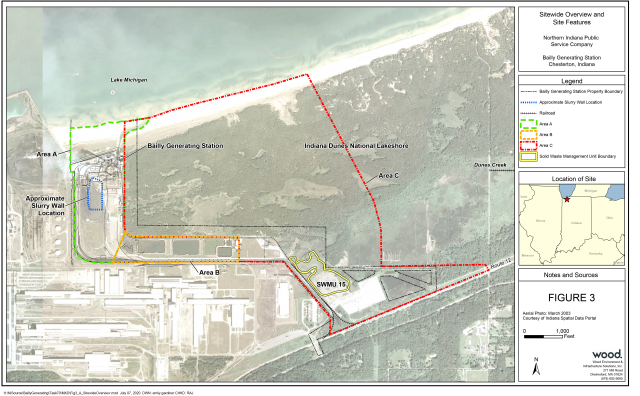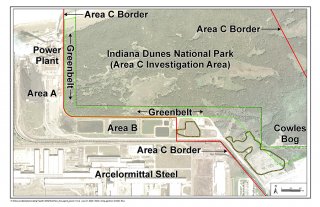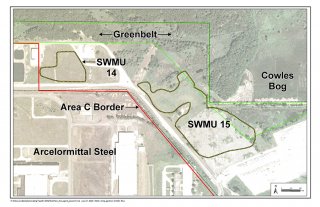Hazardous Waste Cleanup: Northern Indiana Public Service Company (NIPSCO) Bailly Generating Station - Chesterton, Indiana
- Updates
- Cleanup Status
- Site Description
- Contaminants at this Facility
- Institutional/Engineer Controls
- Land Reuse
- Site Responsibility
Updates
The public comment period for the NIPSCO Bailly Generating Facility Statement of Basis closed on Oct. 19, 2020. EPA received a significant number of complex, substantive comments. EPA carefully reviewed all comments and identified areas of concern that necessitated additional evaluation, consideration and negotiation with NIPSCO. We believe the resolution of certain issues balances the need to remediate contamination in and adjacent to the National Park while preserving the sensitive ecosystems within the Park.
EPA is publishing the Final Decision/Response to Comments, which reflects changes to the proposed remedy based upon public comments.
-
NIPSCO Bailly Generating Facility, Area C, Final Decision/Response to Comments
- NIPSCO Bailly Generating Facility Proposed Statement of Basis Question and Answer Session (PDF)(23 pp, 404 K, About PDF) - Aug. 3, 2020
- Hazardous Waste Cleanup: Northern Indiana Public Service Company (NIPSCO) Public Comment form - deadline Oct. 19, 2020
- Factsheet: Statement of Basis Released Public Comment Period Open - July 2020
- Statement of Basis for Area C (PDF) (155 pp, 31.43 MB, About PDF) - June 22, 2020
- Frequently Asked Questions - updated Aug. 31, 2020
- Virtual Public Meeting video best viewed in full screen mode.
Congress amended the Resource Conservation and Recovery Act (RCRA) in November 1984, expanding the Act's cleanup provisions and prompting EPA and its state partners to develop the RCRA Corrective Action Program. The program oversees the investigation and cleanup of nearly 4,000 hazardous waste sites across the country, including many with risks comparable to Superfund sites.
The NIPSCO Bailly Generating Station (Bailly) is a 350-acre former coal-fired power plant located along the southern shoreline of Lake Michigan.
Cleanup Status
Portions of the site (Areas A and B) were remediated under a July 9, 2012 Final Decision document (see “Reports” under Additional Site Information). Those areas included the power generation buildings and surrounding infrastructure. However, since that Final Decision, the Bailly Facility has closed and no longer uses that infrastructure to burn coal or generate electricity.
EPA has selected the remedy for the remaining portion of the site, referred to as Area C. This area includes former coal ash disposal area (Solid Waste Management Unit, or “SWMU 15”), an area historically filled in with sand (SWMU 14) and the adjacent, off-site portions of the Indiana Dunes National Park.
The figure to the right shows all three areas of the facility. Area C is outlined in a red dot-and-dash border. Area A is outlined in a green long-dash border. Area B is outlined in an orange short-dash border.
EPA has issued its Final Decision/Response to Comments, which provides a summary of information found in greater detail in the Statement of Basis, an evaluation of additional information gathered in response to public comments and responses to the public comments.
In response to stakeholder concerns, EPA has made changes to the remedy that was proposed in the SB document. For example, the SB had not proposed a remedy for SWMU 14. This Final Decision now includes a presumptive remedy at SWMU 14. A SWMU 14 coal combustion residual “hot spot” removal with off-site disposal is now required as part of the cleanup. EPA has also selected additional stakeholder engagement as part of the final remedy. More details are provided below, please see the Final Decision/Response to Comments for more information.
SWMU 14: CCR Hot Spot Removal
The SB did not propose a remedy for SWMU 14 based upon the outcome of the risk assessments. EPA considered concerns raised in public comments however and requested that NIPSCO further investigate SWMU 14. The additional soil borings showed that the relatively small amount of CCR present in SWMU 14 is limited and discontinuous in nature. Based on the March 2021 123-soil boring investigation, SWMU 14 is over 73% sand and approximately 2% leachable CCR, fly ash. This Final Decision includes a CCR “hot spot” removal that will excavate 4,100 cubic yards of fill, targeting fine CCR (fly ash) and dispose of it off-site. The off-site disposal facility will be permitted to receive CCR.
SWMU 15: Partial Excavation and Off-Site Disposal of Coal Combustion Residuals with In-Situ Solidification of CCR Below the Water Table
The final remedy selected for SWMU 15 has not changed from the proposed remedy. EPA found stakeholder acceptance of this alternative to be high. The final remedy includes excavation of CCR above the water table (92,000 cubic yards) and disposal at an off-site facility permitted to accept CCR. Remaining CCR below the water table (86,000 cubic yards) will be solidified in place by mixing in cementitious binders designed to reduce the leachability of CCR contaminants through a reduction of both hydraulic conductivity and increased chemical fixation (also referred to as in-situ solidification and stabilization or “ISS”). As part of this component of the remedy, NIPSCO is required to submit a Pilot Test Scope of Work. A modestly sized pilot study is anticipated in order to appropriately frame the Corrective Measures Implementation Plan; therefore, pilot study work must be completed prior to CMI Plan development. In response to public comments, additional supporting information on the SWMU 15 remedy is being provided in Attachment B of the Final Decision/Response to Comments.
Greenbelt and Eastern Wetland: Excavation and Off-Site Disposal
The final remedy selected for the Greenbelt and Eastern Wetland area has not changed from the proposed remedy. EPA found stakeholder acceptance of this alternative to be high. The soil and CCR will be removed to a depth of approximately 3.5 feet below grade based upon existing delineation sampling. This area was delineated during the investigation; however, it may be necessary to collect additional samples to confirm the extent of the CCR. Upon completion of the excavation, native dune sand and topsoil from an EPA-approved borrow pit will be imported for use as backfill. EPA will consult with IDNP on the source of the backfill. The backfilled area will then be re-vegetated with native species selected in consultation with the IDNP and monitored for 10 events over a period of 5 years, as part of the long-term stewardship plan.
IDNP Groundwater: Source Control and Monitored Natural Attenuation
The final remedy for IDNP groundwater has not changed from the proposed remedy. EPA found stakeholder acceptance of this alternative to be high, with two qualifiers: source control at SWMU 14 and stakeholder engagement on the long-term stewardship plan. Monitored natural attenuation was proposed for the off-site groundwater plume that extends down gradient from the site into IDNP. MNA was determined to be the least destructive option to the National Park that is capable of reaching remedial endpoints in a reasonable timeframe. EPA believes the final decision addresses the two qualifiers identified above and is discussed in more detail below and in the Final Decision/Response to Comments.
Previously Barren IDNP Soil Area: Monitored Natural Attenuation
The final remedy for the previously barren soil areas has not changed from the proposed remedy. EPA found stakeholder acceptance of this alternative to be high. In conjunction with source control measures that have already taken place and those that will take place in the future, EPA finds monitored natural attenuation for this recovering area to be the least disruptive to the IDNP.
Facility-Wide: Land Use Institutional Control
Institutional controls will be placed on the Facility property. This requirement was proposed in the SB. EPA found stakeholder acceptance of this requirement to be high. ICs restrict land or resource use at a Facility through legal instruments and are distinct from engineered or constructed remedies. ICs preclude or minimize exposures to contamination or protect the integrity of a remedy by limiting land or resource use through means such as rules, regulations, building permit requirements, well-drilling prohibitions and other types of ordinances. For an IC to become part of a remedy, there must be binding documentation such as land-use restrictions in a recorded environmental covenant, local zoning restrictions, or rules restricting private wells. There will be institutional controls consistent with Indiana Code 13-11-2-193.5 and 13-25-4-24 implemented at this Facility to prohibit interference with the remedy, prohibit the use of groundwater for drinking water and limit the future use of the Facility to a non-residential scenario, such as commercial or industrial. Land use restrictions through ICs will only apply to the Facility property and will not be imposed on the Greenbelt (that is covered by a conservation easement between IDNP and NIPSCO) or IDNP property. The Facility property includes all land within NIPSCO’s property boundary.
Facility-Wide: Financial Assurance
This final remedy requires that NIPSCO demonstrate a financial ability to complete corrective action, including constructing the proposed remedy, monitoring conditions following remedy construction, and conducting long-term stewardship requirements by securing an appropriate financial instrument, consistent with the requirements of 40 C.F.R §§ 264.142 and 264.144. NIPSCO will develop a detailed cost-estimate to support this demonstration. NIPSCO may use any of the following financial mechanisms to make the demonstration: financial trust, surety bonds, letters of credit, insurance, and/or qualification as a self-insurer (corporate guaranty) by means of a financial test. EPA recommends NIPSCO consider using a financial trust or insurance in light of the long-term requirements associated with protecting the National Park. After successfully completing the construction phase of the remedy, NIPSCO may request that EPA reduce the amount of the financial assurance to the amount necessary to cover the remaining costs of the remedy, including monitored natural attenuation, operation and maintenance costs, and long-term stewardship requirements. NIPSCO may make similar requests of EPA at future remedy completion milestones.
Facility-Wide: Long Term Stewardship/Five Year Remedy Review
This final remedy includes a requirement for a long-term stewardship plan. EPA found stakeholder acceptance to be high, with one qualifier: stakeholders expressed a desire to have engagement in the development of the LTS plan. This final decision addresses that request as discussed in more detail below. The LTS plan requirements include: an Institutional Control Implementation and Assurance Plan, five-year remedy review procedures, operation, maintenance and monitoring details. An annual certification that all controls, including institutional controls, are in place and remain effective should be provided for in this plan. Long term remedies will be reviewed and inspected on a five-year basis to ensure the remedy is functioning as intended, the exposure assumptions, toxicity data, cleanup levels, and corrective action objectives are still valid, and any information that comes to light that could call into question the protectiveness of the remedy is considered.
Focused Stakeholder Engagement Group
This final remedy includes a requirement for a focused stakeholder engagement group. This component of the final remedy is being selected based upon public comment and was not proposed in the SB. EPA will work with NIPSCO to develop a small group of representative stakeholders who will participate in a limited series of meetings with NIPSCO and EPA. The purpose of these meetings will be to facilitate stakeholder input on the technical components of the CMI Plan and the Long-Term Stewardship Plan. Stakeholders will have an opportunity to discuss the development of these plans with NIPSCO and EPA and provide input. The public comments submitted requested this opportunity due to the long-term ramifications of this cleanup on the health and sustainability of public lands, specifically, the IDNP.
Site Description
Construction of the coal-fired power plant began in 1959 and it became operational in 1962. Between 1962 and 2018 the facility supplied electricity to the northern half of Indiana. In spring 2018 the facility retired its coal-fired operations.
In 2005, EPA identified a total of 24 areas at the facility that required investigation for possible contamination. A series of sampling events and environmental studies have been conducted since to better understand the nature and extent of contamination. It was determined that coal combustion residuals, or coal ash, was the main source of contamination. Area A included an area that was used for the temporary placement of coal ash on the ground. That area had contributed to contamination of the groundwater and was subsequently cleaned up under EPA’s 2012 Final Decision. EPA’s Final Decision/Response to Comments for Area C includes a remedy for that disposal area and the downgradient areas of impact within the Indiana Dunes National Park.
Contaminants at this Facility
Coal Combustion Residuals, or coal ash, is the primary source of contamination at this Facility. The byproduct of burning coal, CCR typically leaves certain types of metals in the ash which can then contaminate soil or groundwater. At Bailly, contaminants consistently detected above screening levels during the investigation included aluminum, arsenic, boron, cadmium, molybdenum, and selenium. Boron has been identified as a risk-driver for the off-site groundwater which impacts the Indiana Dunes National Park.
The purpose of a Corrective Action Remedial Facility Investigation is to determine whether hazardous waste or hazardous constituents were released into the environment at a Facility, and if so, to evaluate the significance of the releases in terms of risk to human health and the environment. During the investigation, environmental media such as soil, groundwater, surface water, sediments, and biota are sampled and analyzed for contamination.
Under EPA oversight, NIPSCO conducted an extensive multi-media investigation in Area C. Soil, sediment, groundwater, surface water, and plant samples were collected to determine the nature and extent of the contamination surrounding IDNP. Over the course of several years and these iterative studies, sufficient information was gathered to determine the impacts of contamination from the Facility on the National Park and how best to address them.
Over the course of the RFI, the following studies were performed to determine what the chemicals of concern were, where they were located, and what risks they posed:
Soil Investigations
- Test pit investigations to delineate the extent of known and suspected CCR in SWMU 14 and 15;
- Soil borings and collection of over 450 samples to characterize soil and identify areas of exceedances of screening criteria and/or background concentrations;
Groundwater & Hydrogeologic Investigations
- Installation of over 50 groundwater monitoring wells on- and off-site;
- Quarterly groundwater, surface water, and sediment sampling to identify exceedances of screening criteria and/or background concentrations;
- Analysis of over 400 sediment samples, over 400 surface water samples, and over 600 groundwater samples;
- Installation and quarterly measurement of staff gauges in the IDNP to identify water flow in low-lying wetland areas;
- Testing and quarterly monitoring well gauging to identify horizontal hydraulic gradients;
- Sampling of the Lake Michigan groundwater/surface water interface (GSI) within IDNP along the shore of the lake;
Ecological (Plant and Animal) Investigations
- Investigation characterizing the amount of vegetative stress in contaminated portions of IDNP;
- Investigation assessing whether a relationship exists between the absence of IDNP vegetation in barren soil areas and presence of Facility-related constituents in soil;
- Assessment of whether a relationship exists between observation of vegetative stress and the presence of Facility-related constituents in soil and plant tissue;
- Amphibian surveys to observe and evaluate the ecological receptors in IDNP wetlands downgradient from the Facility;
- Amphibian surveys to further assess whether Facility-related constituents were impacting IDNP amphibian populations;
- Studied amphibian toxicity to determine whether components of sediment in the IDNP exhibits toxicity to embryonic and/or larval amphibians;
- Testing rhizome and soil to evaluate the potential for plant bioconcentration of metals and subsequent release back to soils; and
- Studying plant toxicity to assess whether Facility-related constituents were impacting plants in the IDNP.
The investigation concluded that contamination leaving the Facility in groundwater from SWMU 15 and entering the IDNP exceeds applicable ecological standards. Groundwater contamination is found in the surface waters of IDNP as a result of the groundwater and surface water being connected. Stressed vegetation has been observed and studied within the National Park. There is a complicated hydrogeologic cycle between the groundwater, surface water and sediment as it pertains to the bioavailability of certain metals. The most chronically exposed receptors to this cycling of contamination between groundwater, surface water, and sediment are plants, as studies demonstrated Facility contamination (primarily boron) within the plant tissue.
Institutional and Engineering Controls at this Facility
Code 13-11-2-193.5 and 13-25-4-24 implemented at this Facility to prohibit interference with the remedy, prohibit the use of groundwater for drinking water and limit the future use of the Facility to a non-residential scenario, such as commercial or industrial. Land use restrictions through ICs will only apply to the Facility property and will not be imposed on the Greenbelt (that is covered by a conservation easement between IDNP and NIPSCO) or IDNP property. The Facility property includes all land within NIPSCO’s property boundary.
Land Reuse Information at this Facility
NIPSCO has indicated that the type of future reuse or redevelopment at the Bailly facility is currently undecided. This Statement of Basis presumes that future land use at Bailly will be limited to uses consistent with the commercial/industrial cleanup levels. If a non-commercial/industrial use is proposed in the future, then additional risk associated with the specific alternative use must be evaluated. Should the analysis show more cleanup is necessary, then to be protective, additional work would be needed to support the alternative use. At this time, given the extent of the area’s industrial development and the existence of a buffer zone between the industrial area and the National Park, EPA believes that the industrial/commercial use designation is appropriate and consistent with EPA guidance. It is also consistent with the Porter County Zoning Ordinance, which currently has the facility zoned as “High Impact Use” and the buffer area zoned as “Greenway Use”.
Site Responsibility at this Facility
The RCRA Corrective Action program designates the lead agency as the entity that oversees the investigation and cleanup work. The program was designed to reduce the number of tax-payer Superfund sites. Therefore, the company (NIPSCO) is responsible for the cost and implementation of work. EPA oversees and must approve of all work conducted under the program.




